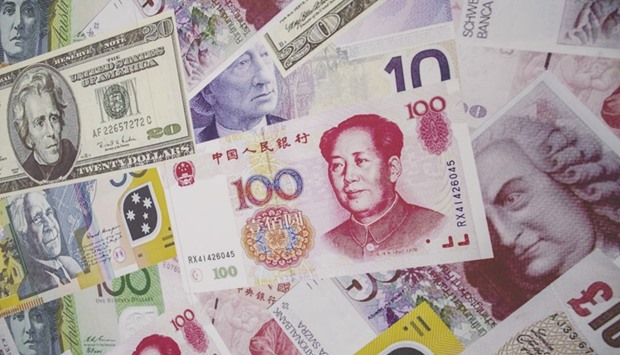China’s foreign exchange reserves fell the most in nine months in October and by far more than expected to the lowest since March 2011, indicating further capital outflows despite recent signs the world’s second-largest economy is stabilising.
Reserves fell $45.7bn last month to $3.121tn, the biggest monthly decline since January, compared with a near $19bn fall in September, central bank data showed
yesterday.
The October drop was the fourth in a row, and exceeded the previous three months combined, though analysts said a surging US dollar may have accounted for much of the move.
Economists polled by Reuters had predicted a decline of around $26bn to $3.14tn from $3.166tn at end-September, a five-year low.
The central bank is widely believed to have sold US dollars to cushion the yuan currency’s descent in October as it fell to six-year lows. “The biggest decline in China’s FX reserves since the start of the year has more to do with valuation effects than increased intervention,” Capital Economics said
in a note.
“Capital outflows remain substantial but probably eased last month.”
Growing expectations that the US Federal Reserve will raise interest rates in December boosted the dollar by about 3% versus major currencies in October, reducing their value in China’s reserves.
Coupled with worries about China’s economy and its rapidly rising debt, that has stoked capital outflows and weighed on the yuan, analysts say.
China also may have suffered losses on its investments in US Treasuries and debt in other developed countries, some analysts said. “The pressure on the yuan remains big as we approach the US rate-hike window in December,” analysts at Haitong Securities said in a note. The People’s Bank of China (PBoC) had sold a net 337.5bn yuan ($50.1bn) worth of foreign exchange in September, as it sought to support the weakening yuan as outflows picked up.
Persistent capital outflows could raise pressure on the PBoC to cut banks’ reserve requirement ratio (RRR), but analysts believe the central bank is trying to use other policy tools, such as the medium-term lending facility and standing lending facility, to inject cash into the banking system. China’s reserves, the largest in the world, fell by a record $513bn last year after Beijing devalued the yuan, sparking a flood of capital outflows that threatened to destabilise the economy and alarmed global financial markets.
Currency strategists polled by Reuters expect the yuan to depreciate by nearly 2% more in the next 12 months to levels not seen since the global financial crisis.
China’s economy expanded at a steady 6.7% in July-September, fuelled by government infrastructure spending and a housing boom. But some analysts say the property rally may have peaked, while policymakers are increasingly concerned about the dangers of relying on debt-fuelled stimulus for too long.
“Looking ahead, we think a further slide in the Chinese currency against a globally-strong dollar may cause capital outflows to accelerate again,” Capital Economics said.
“The PBoC could choose to intervene to stabilise the renminbi against the dollar but it would have to accept renewed trade-weighted renminbi appreciation, a price that it has so far been reluctant to pay.”
China’s weakening currency is a key concern for more than half of the country’s wealthy elite, with 60% of them planning to buy property overseas in the next three years as a hedge against yuan depreciation, according to Hurun report, a monthly magazine best known for its “China
Rich List”.
Over a dozen Chinese cities imposed new or tougher restrictions on house purchases in October to curb soaring home prices.Beijing also has been trying to stem the flow of capital abroad with a string of measures aimed at closing loopholes and clamping down on illegal transfers.

Yuan , US dollar and euro banknotes are seen outside a foreign exchange shop in Hong Kong. China’s foreign exchange reserves fell $45.7bn last month to $3.121tn, the biggest monthly decline since January, compared with a near $19bn fall in September, PBoC data showed yesterday.
